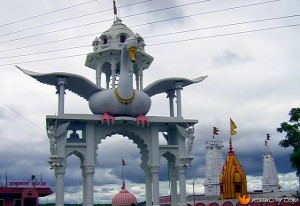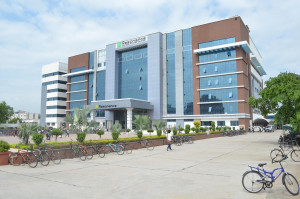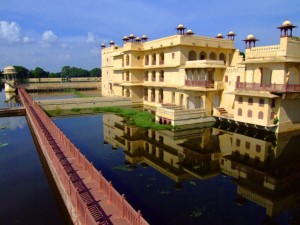Introduction to Kota
Kota formerly known as ‘Kotah’, is the 25th largest district in the northern Indian state. The town of Kota was once the part of erstwhile Rajput Kingdom of Bundi. The history of the city dates back to the 12th century AD when the Hada clan, a Chauhan Rajput chieftain, Rao Deva, conquered the territory and founded Bundi and Hadoti.
Later, in the early 17th century, during the reign of the Mughal Emperor Jahangir, the ruler of Bundi – Rao Ratan Singh, gave the smaller principality of Kota to his son, Madho Singh. Since then Kota became a hallmark of the Rajput gallantry and culture. The independent state of Kota became a reality in 1631 when Rao Madho Singhal, the second son of Rao Ratan of Bundi was made the ruler, by the Mughal Emperor Jahangir. Soon Kota outgrew its parent state to become bigger in area, richer in revenue and more powerful.
Kota’s Geographical Scenario
 Godawari Dham, Kota
Godawari Dham, Kota
Kota is located along eastern bank of the Chambal River in the southern part of Rajasthan. It is the third largest city of Rajasthan after Jaipur and Jodhpur. Kota is well connected with rail and road transport to almost all the major cities of the country. Being on the heart of rail line connecting Delhi-Mumbai rail line every train takes a halt at Kota junction. The nearest airport to Kota is at Jaipur (240kms); it is very well connected by both rail and road to Kota. Kota Junction is one of the divisions in West Central Railway with nearly around 100 trains taking halt at Kota Junction. National Highway no. 12 (Jabalpur-Jaipur) and National Highway no. 76 passes through the district. National Highway no. 76 is a part of East-West Corridor; the city also has three bus stands.
Erstwhile, Kota was the industrial capital of the state but with due course of time many of the industries had faced challenges and stopped operations. Still, Kota has few of the industries who did stand up against the adversities and have created their own identity
a. Kota Stone Industry
The fine-grained variety of limestone is known as Kota stone, with rich greenish-blue and brown colours. Kota stone are tough, non-water-absorbent, non-slip, and non-porous. The varieties include Kota Blue Natural, Kota Blue Honed, Kota Blue Polished, Kota Blue Cobbles, Kota Brown Natural and Kota Brown Polished
b. Kota Doria and Saree
Kota is known for the fine translucent muslins called Masuria Malmal. Kota saris are popularly known as ‘Masuria’ in Kota and Kotadoria outside the state. ‘Doria’ means thread. The warp and weft use a combination of threads creating a fine chequered pattern (Khat) where the cotton portion provides firmness while the silk lends a gossamer finish to the fabric. Kota saris and weaves are found around the country and have become one of the most beautiful and elegant saris worn by humble housewives to actresses.
Educational Scenario
The educational scenario of Kota and Hadoti division is very healthy, having a good number of institutions of school education and higher education. The schools are affiliated to either Central Board of Secondary Education (CBSE) & Rajasthan Board of Secondary Education (RBSE). Kota as well as the adjoining districts have degree colleges, engineering colleges, technical institutions, medical college, nursing colleges, teachers training colleges, management colleges etc. Hundreds of schools in complete Hadoti division including Kota itself indicates the awareness amongst the people for education and its importance.
| District |
CBSE Schools |
RBSE Schools |
Total Schools |
| Kota |
58 |
1056 (Govt.: 552 | Pvt.: 504) |
1114 |
| Baran |
11 |
1101 (Govt.: 555 | Pvt.: 546) |
1112 |
| Jhalawar |
11 |
1189 (Govt.: 759 | Pvt.: 430) |
1200 |
| Bundi |
5 |
1030 (Govt.: 515 | Pvt.: 515) |
1035 |
| Total |
85 |
4376 |
4461 |
Higher Education in Kota
a. Universities
- Rajasthan Technical University (Government)
- University of Kota (Government)
- Vardhman Mahaveer Open University (Government)
- Career Point University (Private)
- Agriculture University Kota (Government)
- Indian Institute of Information Technology (Government) – Announced in 2013
b. Colleges
- University College of Engineering (UCE), Kota
- Modi Institute of Technology
- R N Modi Engineering College, Ranpur, Kota
- Gurukul College of Engineering and Technology, Ranpur, Kota
- Maharishi College of Engineering and Technology, Ranpur, Kota
- Maharishi Arvind International Institute of Technology, Ranpur, Kota
- Bal Krishna Institute of Technology, Ranpur, Kota
- Apex International Institute of Technology, Ranpur, Kota
- Government Medical College, Kota
- Daswani Dental College, Ranpur, Kota
- Government College, Kota
- JDB Girl’s College, Kota
- Commerce College. Kota
- Modi Institute of Management & Technology, Kota
- Om Kothari Institute of Management & Research, Kota
Kota Coaching Institutes – The Result Factories
 Resonance Eduventures Limited, Kota
Resonance Eduventures Limited, Kota
Once considered as the industrial capital of the State, Kota today is renowned as ‘Coaching Hub’/ ‘Educational City’/ ‘Mecca of Coachings’ of India. With few prominent names of coaching institutes viz. Resonance, Bansal Classes, Allen Career Institute, Vibrant Academy, Career Point etc. and hundreds of other small other institutes, Kota is now a home of nearly 1.10Lac+ students migrated from urban and rural belts of India.
Students come to Kota every year to prepare for their aspirations of cracking prominent engineering and medical entrance examinations. The number of students coming for coaching has seen a rise every year irrespective of the changes in pattern of entrance examinations. In an article featured in a leading news daily it captioned Kota’s Coachings’ as an economy of 1700Crores+. Kota Coachings’ have been the major contributor in the economic development of Kota; many subsidiary industries have prospered around the coaching institutions.
Kota Tourism
 Abheda Mahal, Kota
Abheda Mahal, Kota
Kota is the third largest city in the North Indian state of Rajasthan after Jaipur and Jodhpur. This city lies in the eastern bank of the Chambal River and it is popular for its content of medieval history and modern age industrialization. Apart from the several places of tourist interests like monuments and forts, Kota is immensely famous for it’s parks and gardens.
Some of the most popular tourist destinations in Kota are Umed Bhawan Palace, City Fort Palace, Darrah Wildlife Sanctuary, Taragarh Fort, Jagmandir Palace, Brijraj Bhawan Palace, Rao Madho Singh Museum, Chambal Gardens, Chhatra Vilas Garden etc. The forts and palaces are the main attraction of the city with beautiful architecture and amazingly construction. The tourist places like near Kota are Baroli and Sitabari are must visit place of the Rajasthan State.
The best time to explore the city is in winters that are from October to February, during winter temperature reaches 10 to 31 degrees Celsius which makes the atmosphere cool and pleasant to explore the city.













